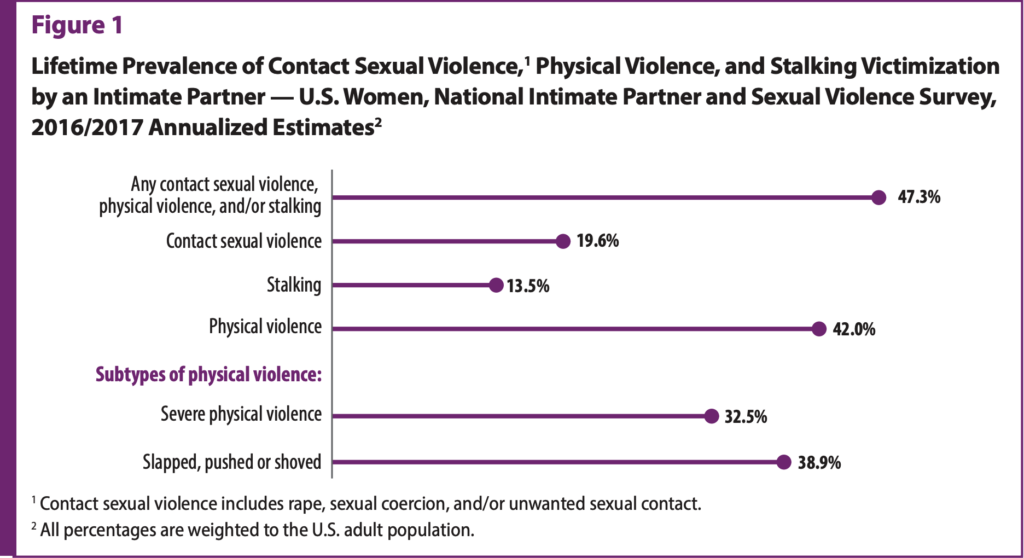Intimate Partner Violence
Intimate Partner Violence
Data highlight
Oklahoma ranks 39 (out of 51) for the rate at which women experience intimate partner violence (IPV). Nevada had the highest rate at 61.8%. Utah had the lowest at 31.7%.
HOW WE STACK UP
Percentage of women 18 and older who experienced psychological, sexual, or physical violence, and/or stalking by an intimate partner in their lifetime.


YOU MIGHT ALSO LIKE
Definition
Intimate partner violence (IPV) is when one person in a current or previous romantic relationship tries to control their partner using physical, emotional, or financial violence. Abuse can vary in frequency and severity and often includes multiple types.
Why we care:
Intimate partner violence (IPV) is a serious, sometimes life-threatening experience for women.
The National Intimate Partner and Sexual Violence Survey 2016/2017 Report on Intimate Partner Violence definition for intimate partner violence-related impacts includes “being fearful, being concerned for safety, any post-traumatic stress disorder symptoms, injury, need for medical care, need for help from law enforcement, missing at least one day of work, or missing at least one day of school. The following impacts were included in the lifetime estimate only: specific types of physical or mental injuries, need for housing, need for victim advocate services, need for legal services, and contacting a crisis hotline.”
Nearly 1 half of women in the US (47.3%) and over half of women in Oklahoma (51.5%) have experienced some form of contact sexual violence, stalking, or physical violence by an intimate partner (See Figure 1).

Leemis R.W., Friar N., Khatiwada S., Chen M.S., Kresnow M., Smith S.G., Caslin, S., & Basile, K.C. (2022). The National Intimate Partner and Sexual Violence Survey: 2016/2017 Report on Intimate Partner Violence. Atlanta, GA: National Center for Injury Prevention and Control, Centers for Disease Control and Prevention.
These incidents are also underreported. According to the National Crime Victimization Survey, about 58% of incidents of intimate partner violence were reported to law enforcement in 2019.
Women are often forced to abandon financial stability (see Women Experiencing Poverty), housing (see Access to Safe and Affordable Housing), and friends/family to escape an abusive situation. This is one reason some choose to stay even if they have safety concerns.
IPV is linked to over half of female homicides nationwide. Even when not immediately deadly, IPV can have profound and lifelong effects on a woman’s health. Survivors of IPV are at increased risk of mental health disorders (from trouble sleeping to substance use issues), traumatic brain injury, suicide, and a wide variety of other physical conditions like diabetes and heart disease.
The social and economic consequences of leaving an abuser can be staggering – one estimate puts the lifetime economic burden for a single female IPV survivor at $103,767.
Finally, decades of research shows that intimate partner violence negatively affects children in the home. Witnessing IPV is considered an Adverse Childhood Experience (ACE) (see ACEs Reported), putting Oklahoma’s youth at increased risk of child abuse/neglect, health issues, and continuing the cycle in their own intimate relationships.
Considerations:
The data landscape of IPV is tricky for two primary reasons.
- Though there are many different and often overlapping elements to IPV, most data and research focus on its physical/sexual forms. Other types of IPV like psychological and economic abuse are underexplored.
- IPV is underreported for a variety of reasons including fear, coercion, and lack of resources. Only about half of all incidents are reported to law enforcement.
- Though there are many different and often overlapping elements to IPV, most data and research focus on its physical/sexual forms. Other types of IPV like psychological and economic abuse are underexplored.
These challenges help explain why comprehensive data on intimate partner violence is dated.
While it is true that other forms of abuse, outside of physical/sexual forms, are under researched/studied, NISVS did measure psychological aggression in its most recent report.
The National Intimate Partner and Sexual Violence Survey 2016/2017 Report on Intimate Partner Violence defines psychological aggression as “expressive aggression (insulting, humiliating, or making fun of a partner in front of others) and coercive control and entrapment, which includes behaviors that are intended to monitor, control, or threaten an intimate partner.”
For women, 49.4% experienced psychological aggression from an intimate partner in their lifetime, and for men, 45.1% had this experience. In Oklahoma, 56.7% of women and 45.9% of men experienced psychological aggression from an intimate partner in their lifetime.
Though they aren’t as comprehensive or comparable across states, there are several more recent datasets we can look at to understand how often Oklahoma women are experiencing IPV.
In 2021, 3.5% of Oklahoma women reported they had experienced unwanted sex or violence by an intimate partner in the last 12 months. 30.3% indicated they had been hit, slapped, pushed, kicked, or physically hurt by a partner at some point in their lives.
Between 2011 and 2021, of the 437 Oklahomans killed by a current or former intimate partner, 300 (68.6%) were female and 137 (31.4%) were male. On average, 27 women and 12 men were killed each year in Oklahoma by an intimate partner. In 2021 and consistent with previous years, almost three quarters of the state’s intimate partner homicides were committed by men.
Through more recent and inclusive data collection and analysis, we know that women who are disabled, members of the LGBTQ+ community, and/or Black, Brown, or Indigenous, are more likely to experience IPV. Although Black women make up less than 10% of Oklahoma’s adult female population, they constituted almost 1 out of every 4 domestic violence homicide victims in 2020. Similarly, Native American women comprised 11.6% of adult female victims, a rate almost 47% higher than their share of the state’s population.
What we can do:
- Advocate for more frequent and inclusive data collection that covers all forms of sexual and intimate partner violence
- Increase funding for sexual and intimate partner violence programs that offer inclusive, victim-centered, and trauma-informed support across the state
- Work to improve and increase wellness and healthy relationships curriculum, such as Social and Emotional Learning (SEL), for students
- Work with corporations, institutions, and law enforcement agencies to ensure that allegations of intimate partner violence are being taken seriously, investigated promptly and thoroughly, and prosecuted
- Advocate for diversified funding for Intimate Partner Violence (IPV) and Domestic Violence (DV) providers, emphasizing a reduction in restrictive conditions associated with funding
This issue brief was written by Metriarch staff as part of our Data Lookbook. Peer review and contributions provided by: Angela Beatty, Brandon Pasley, and Mikela Rhodes with YWCA Oklahoma City.
Suggested citation
Metriarch. “Social Dynamics,” Data Lookbook (2024). URL: metriarchok.org/intimate-partner-violence.
- Last updated May 2, 2024
Share this page:




